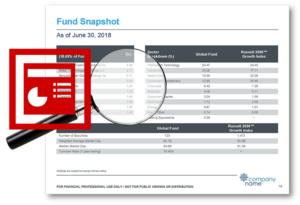3 Ways Big Data Applies to Finserv Marketing
 “Big Data” is a term you hear all the time these days. It may sound like something everybody needs, but what does it mean for finserv marketers? By Gartner’s definition, big data is “high volume, high velocity, and/or high variety information assets that require new forms of processing to enable enhanced decision making, insight discovery, and process optimization.”
“Big Data” is a term you hear all the time these days. It may sound like something everybody needs, but what does it mean for finserv marketers? By Gartner’s definition, big data is “high volume, high velocity, and/or high variety information assets that require new forms of processing to enable enhanced decision making, insight discovery, and process optimization.”
Or, in layman’s terms, it’s large amounts of complex information that’s extremely valuable, but difficult to analyze and use.
As a software engineer for over 15 years, I’ve spent a great deal of my career specializing in handling complicated data related to automating and streamlining marketing and client communications efforts for financial services firms. When we talk about “big data” in the context of financial services, here’s what I see as being particularly pertinent to finserv marketers:
1. Volume: Find effective ways to analyze large amounts of data
Web analytics is usually the first thing people think of when they hear “big data” and marketing in the same sentence, but tracking consumer behavior on your website is only one part of the equation. And connecting your web visitor data to your email follow-up system or lead generation system is only the tip of the iceberg. With a growing variety of marketing mediums and messages being delivered, finserv marketers need to find way to empirically test and examine which messages are most effective.
Here’s an example: Say your sales force is delivering personalized presentations to their clients and prospects. They’re picking and choosing which products and corresponding marketing materials are most appropriate for their clients. However, if you’re using a presentation management platform to organize your content, you should also be using reporting tools to track certain metrics. For one thing, you can examine which materials are most commonly presented. This will give you insight into what content is relevant and what is not. You could even examine how the use of certain content contributes to closing sales. If these elements don’t coincide with the content your team uses most frequently, it’s probably time for a change.
This kind of data can help you determine what elements your marketing team should focus on when developing marketing collateral. If your team is pitching a product frequently but rarely closing a sale, the message may need to be tweaked. On the other hand, if you’re not pitching a certain product very often but generally closing business when you do, it could be your sales team that needs an adjustment. Either way, it’s easier to see what’s working and what isn’t and respond accordingly.
Once you’ve introduced big data into your marketing collateral management, you can create a new feedback loop between sales and marketing, which will result in much more interactive collaboration between the two teams. This creates an issue of “volume” because the collaboration may produce larger quantities of materials that allow more effective combinations. Helping sales and marketing work better together should be an ongoing initiative. By looking at content usage data, sales results and tying in CRM, marketers can offer something that will really enhance that relationship.
2. Velocity: Make data available immediately to produce timely, personalized and targeted content
ING’s “Find Your Number”campaign is a nice, straightforward example of the impact of data velocity. When visitors plug in a few figures, the website automatically calculates the amount of money required for their retirement. Imagine if you could build a full product brochure, advice packet, or even an enrollment kit like this. Simply select the appropriate educational material and images that match an economic or employment profile, then include an appropriate selection of products that provide charts and details of hypothetical investment performance. These figures can all be calculated from that person’s actual savings and contributions to their account for their risk tolerance. You could also include any other personal insights the advisor might have or other details from your CRM. Now wouldn’t that make a compelling piece? Wouldn’t it be great if all marketing teams worked like that?
Financial products are complex. There are a wide array of instruments and investments suited to different types of investors. Similarly, there’s a considerable variance in the level of knowledge among financial products consumers. On any given day, one financial advisor might meet with the sponsor of a large corporate retirement plan who has helped manage millions of dollars for many years, and an hourly worker who’s just trying to get his kids through school.
To have the right impact, a marketing message must be tailored to its audience and speak to them on their level. Financial advisors and other salespeople are great at delivering messages appropriate for their various audiences, but marketers can make a salesperson’s job easier by using all of the available data to automate these targeted messages for each type of investor.
In this case, the challenge is connecting client profiles and sales insights with marketing content so that the final piece gets delivered to the right recipient. Whether it’s a hard-copy investment brochure, a personally delivered presentation, or an email teaser, the problem is basically the same: How do you organize and categorize the content that makes up your message so that it is readily and immediately available?
The challenge here is primarily with data velocity. By traditional means, dynamic marketing collateral, even digital, is not immediately available to those that need to use it.
There’s no silver bullet to solve this “big data” problem. However, having the right tools makes it easier to approach. Using technology solutions, sales and marketing teams can aggregate and integrate all of the available data in more effective ways. More and more marketers are going to have to custom-craft their messages to differentiate their products and make them compelling in a market that is becoming increasingly crowded.
3. Variety: Deliver targeted, relevant data from a variety of ever-changing sources
The growing complexity of finserv products poses another big data problem, “variety”. The data driving your marketing message is constantly evolving. There’s always new market data and new profile information you’d like to use to drive that personalized messaging. And then of course there are product features and regulatory requirements that you need to keep on top of. It’s becoming harder to explain how these products work and what makes one platform better than another.
The job of marketers is to deliver a unique and compelling message that differentiates their products from the competitors’. To do this successfully, you actually do need to have a unique and compelling message, which can be accomplished through new data visualizations, new data comparisons, and other creative techniques. You’ll have to continually emphasize and refine your brand and consistently update your message to keep up with product changes and market trends. With “big data” techniques, this data variety has become easier to solve and finserv marketers are going to have to tackle it more effectively to tell their stories.
Conclusion
The nice thing about all the buzz around Big Data is that it’s brought enough attention to the challenges facing finserv marketers, that there are almost always solutions. Now, it’s possible to collect and use virtually any data point you can imagine. So it’s time to dream big.
Thanks for reading! You can connect with Noah Menikoff on LinkedIn.
Here are some related resources that might interest you:







 Compare the Top 3 Finserv Content Automation Vendors [White paper]
Compare the Top 3 Finserv Content Automation Vendors [White paper] Create Pitchbooks the Drive Sales [White paper]
Create Pitchbooks the Drive Sales [White paper] Build vs. Buy: Should Your Financial Services Firm Outsource or Insource Marketing Technology? [White paper]
Build vs. Buy: Should Your Financial Services Firm Outsource or Insource Marketing Technology? [White paper]  10 Tips for Rebranding your Fund Marketing Documents [White paper]
10 Tips for Rebranding your Fund Marketing Documents [White paper]

